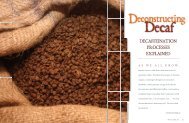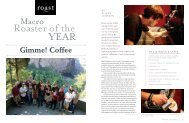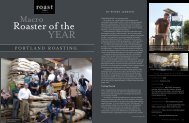to download a low resolution preview of this article - Roast Magazine
to download a low resolution preview of this article - Roast Magazine
to download a low resolution preview of this article - Roast Magazine
Create successful ePaper yourself
Turn your PDF publications into a flip-book with our unique Google optimized e-Paper software.
MARCHING<br />
Forth<br />
Battling the<br />
C<strong>of</strong>fee Berry Borer<br />
in Hawaii<br />
by Marc Wortman and David Cook<br />
Just three years ago, Hawaii’s c<strong>of</strong>fee industry could call<br />
itself blissfully free from the no<strong>to</strong>rious c<strong>of</strong>fee berry borer,<br />
which had invaded c<strong>of</strong>fee crops worldwide. This tiny beetle,<br />
known as la broca in Spanish, is capable <strong>of</strong> causing major<br />
damage. As the bean hardens, the beetle drills in<strong>to</strong> it and<br />
C<strong>of</strong>fee cherries in Kona,<br />
Hawaii. C<strong>of</strong>fee farmers on<br />
the Big Island are battling<br />
the c<strong>of</strong>fee industry’s most<br />
infamous pest, the c<strong>of</strong>fee<br />
berry borer.<br />
pho<strong>to</strong> by David Cook<br />
harms a large amount <strong>of</strong> producers’ harvest.<br />
continued on page 82<br />
80 roast May | June 2013 81
Marching Forth | Battling the C<strong>of</strong>fee Berry Borer in Hawaii (continued)<br />
But Hawaii’s free-and-clear status changed<br />
in August 2010, when the beetle was positively<br />
identified on farms in Kona and, later, in<br />
parts <strong>of</strong> the Big Island’s Ka‘u district. All Kona<br />
c<strong>of</strong>fee farms are now infested, though cherry<br />
infestations can range from under 1 percent <strong>to</strong><br />
nearly 100 percent. No one knows how the beetle<br />
arrived in Kona, but given the ease <strong>of</strong> global<br />
shipping and travel, its arrival was inevitable.<br />
A tiny beetle native <strong>to</strong> Africa, the c<strong>of</strong>fee berry<br />
borer has now been identified in more than 70<br />
countries and is considered the world’s most<br />
harmful pest <strong>to</strong> c<strong>of</strong>fee crops. The female is about<br />
2 mm long, about the size <strong>of</strong> a grain <strong>of</strong> rice, and<br />
the males are about half that size. The presence<br />
<strong>of</strong> the insect can affect the whole economy<br />
that depends on c<strong>of</strong>fee production, potentially<br />
destroying an entire harvest—a major concern<br />
for Kona’s approximately 700 c<strong>of</strong>fee farmers,<br />
who in 2011 harvested 8.3 million pounds <strong>of</strong><br />
c<strong>of</strong>fee, valued at $34.4 million, according <strong>to</strong> the<br />
most recent data from the National Agricultural<br />
In 2012, the beetle’s widespread impact led<br />
some Kona c<strong>of</strong>fee farms <strong>to</strong> inform roasters that<br />
there was serious doubt whether they could<br />
fill their existing obligations and contracts, let<br />
alone any new ones. Greenwell Farms was forced<br />
<strong>to</strong> tell prospective buyers that it would be at least<br />
a year before the farm would be in a position<br />
<strong>to</strong> sell them green c<strong>of</strong>fee. Situated in the heart<br />
<strong>of</strong> the Kona district since 1850, Greenwell not<br />
only manages a farming operation but also<br />
purchases c<strong>of</strong>fee cherry from hundreds <strong>of</strong><br />
farmers throughout Kona. The farm is managed<br />
by fourth-generation grower Tommy Greenwell<br />
on just under 100 acres <strong>of</strong> some <strong>of</strong> the most<br />
productive land in the Kona district. Greenwell<br />
Farms is closely involved with the fight<br />
against the beetle, given the farm’s size and<br />
involvement in purchasing cherry from other<br />
local growers.<br />
In Kona, yield has dropped and grades<br />
such as Kona Extra Fancy have been difficult<br />
<strong>to</strong> obtain. Growers are having <strong>to</strong> discard much<br />
Cherries afflicted by the c<strong>of</strong>fee berry borer. | pho<strong>to</strong> by David Cook<br />
Statistics Survey. continued on page 84<br />
A close-up <strong>of</strong> a c<strong>of</strong>fee cherry infested by the c<strong>of</strong>fee berry borer. | pho<strong>to</strong> by David Cook<br />
82 roast May | June 2013 83
Marching Forth | Battling the C<strong>of</strong>fee Berry Borer in Hawaii (continued)<br />
A c<strong>of</strong>fee bean and the c<strong>of</strong>fee berry borer.<br />
pho<strong>to</strong> by Peggy Greb, USDA<br />
A close-up <strong>of</strong> the c<strong>of</strong>fee berry borer.<br />
pho<strong>to</strong> by Eric Erbe, colorized by Chris Pooley, USDA<br />
more parchment due <strong>to</strong> floaters and consumed or rotten beans resulting from<br />
beetle damage. As a result <strong>of</strong> falling yields, the price per pound <strong>of</strong> cherry has<br />
increased <strong>to</strong> $1.65 per pound in Kona during peak demand.<br />
Greenwell Farms has collaborated with the Kona C<strong>of</strong>fee Farmers Association<br />
and the University <strong>of</strong> Hawaii’s College <strong>of</strong> Tropical Agriculture and Human<br />
Resources <strong>to</strong> produce a tu<strong>to</strong>rial video for farmers called “Controlling the C<strong>of</strong>fee<br />
Berry Borer.” In <strong>this</strong> video, Tommy Greenwell warns <strong>of</strong> the damage <strong>to</strong> crops:<br />
“We’re seeing a weighted average <strong>of</strong> between 20 and 25 percent [<strong>low</strong>er yield]. It’s<br />
only going <strong>to</strong> get worse if we don’t start taking care <strong>of</strong> it now.” The collaboration<br />
al<strong>low</strong>s for integrated pest management by bringing <strong>to</strong>gether the University <strong>of</strong><br />
Hawaii’s technical expertise in plant and soil sciences, the farmers who are<br />
ultimately responsible for controlling the infestation, and Greenwell Farms,<br />
which has a vested interest in the solution.<br />
Greenwell has worked <strong>to</strong> band growers <strong>to</strong>gether, presenting the Kona C<strong>of</strong>fee<br />
Farmers Association in January 2013 with data that he has been keeping on<br />
infestation rates for the past two growing seasons. According <strong>to</strong> the newspaper<br />
West Hawaii Today, he was quoted at the time saying, “We do not have control <strong>of</strong><br />
the beetle yet, though there are a few farmers that do.”<br />
C<strong>of</strong>fee producers have found it difficult <strong>to</strong> curb the spread <strong>of</strong> the beetle<br />
because it is such an unusual insect, explains Fernando E. Vega, a research<br />
en<strong>to</strong>mologist with the USDA Agricultural Research Service. “The female goes<br />
inside the berry, and then she lays eggs, and there are 10 females for every<br />
male. The brothers will inseminate their sisters inside the berry, so when those<br />
females come out <strong>of</strong> the berry, they are ready <strong>to</strong> lay eggs. You have<br />
a machine in [the cherry that is] producing females. There is a very<br />
short window when they are outside the berry, and that’s why they<br />
are so difficult <strong>to</strong> control.”<br />
As Vega explains, females lay a varying number <strong>of</strong> eggs; one<br />
academic paper tracked 70 eggs within a single cherry, while another<br />
scientist counted 287 eggs. Because the insects are so tiny, scientists<br />
have not been able <strong>to</strong> track how far they may travel <strong>to</strong> find new<br />
homes. A pregnant female will live inside one host berry for her<br />
lifetime, and her female progeny will fly away <strong>to</strong> find new berries <strong>to</strong><br />
colonize. Males cannot fly and remain in their original c<strong>of</strong>fee cherry<br />
for their entire life. Scientists in different countries have reported<br />
life spans ranging from about a month <strong>to</strong> about a half-year for a<br />
single beetle.<br />
Containment Procedures<br />
Collaboration between farmers is a necessity, as the beetle can<br />
quickly migrate <strong>to</strong> neighboring farms. In Kona, that makes it<br />
everybody’s problem. Farmers are fol<strong>low</strong>ing four steps in response <strong>to</strong><br />
the infestation: field sanitation, insecticidal fungus, trapping, and<br />
worker education.<br />
Field Sanitation<br />
Many experts on the beetle believe that field sanitation is the most<br />
effective form <strong>of</strong> control. Proper sanitation means that every cherry<br />
is removed from the farm at the end <strong>of</strong> the harvest season, including<br />
those cherries that fall on the ground. As the beetle can migrate from<br />
one part <strong>of</strong> the field <strong>to</strong> another, harvesters are instructed <strong>to</strong> move the<br />
cherry as little as possible. In Kona, farmers did not perform field<br />
sanitation prior <strong>to</strong> the arrival <strong>of</strong> the c<strong>of</strong>fee berry borer, says Shawn<br />
Steiman, a Hawaii-based c<strong>of</strong>fee scientist and consultant who works<br />
with farmers <strong>to</strong> manage the borer beetle.<br />
Though sanitation is effective in theory, it is also problematic.<br />
Growers must harvest all fruit, including cherries on the ground and<br />
between rocks, Vega says. “If you miss one berry, and that berry has<br />
the insect, that’s enough <strong>to</strong> start infestation again.”<br />
Sanitation measures also can be pricey for the producer, who must<br />
invest in extra pay for workers’ time in the field. “If I do sanitation<br />
in my one acre here, and you are my neighbor, and you don’t do<br />
sanitation in yours, I’m wasting my time,” Vega says. “So you need<br />
coordination. And a lot <strong>of</strong> people simply won’t do it because they have<br />
<strong>to</strong> pay somebody <strong>to</strong> do it for them, or they need help doing it. From<br />
my experience, sanitation is a huge challenge because you’ve got <strong>to</strong><br />
coordinate the growers <strong>to</strong> do it <strong>to</strong>gether.” However, sanitation used<br />
continued on page 86<br />
84 roast May | June 2013 85
Marching Forth | Battling the C<strong>of</strong>fee Berry Borer in Hawaii (continued)<br />
in combination with the other three steps—<br />
spraying insecticidal fungus, trapping and<br />
worker education—should make a difference<br />
in the field, Vega says.<br />
Insecticidal Fungus<br />
An insecticidal fungus was also approved and<br />
recommended <strong>to</strong> Kona farmers for spraying<br />
crops. This pesticide is certified organic<br />
and was made available for sale throughout<br />
Kona. Each acre where the beetle is observed<br />
requires 1–3 ounces <strong>of</strong> fungus mixed in 30-<br />
100 gallons <strong>of</strong> water, sprayed anywhere from<br />
twice a month <strong>to</strong> every 60 days, depending<br />
on the extent <strong>of</strong> infestation.<br />
Farmers are instructed <strong>to</strong> spray the<br />
ground around trees, as well as the crops<br />
themselves, <strong>to</strong> ensure a thorough treatment.<br />
The fungus has no effect on the eventual<br />
flavor <strong>of</strong> the c<strong>of</strong>fee.<br />
Spraying for the insect is<br />
problematic because the beetles spend<br />
most <strong>of</strong> their lives inside <strong>of</strong> c<strong>of</strong>fee<br />
cherries, which the fungus does not<br />
penetrate. If fungal spores come in<br />
contact with insects, the fungus will<br />
multiply inside the insect and kill it.<br />
And like sanitation, producers must<br />
budget for extra time that workers must<br />
spend in the field, in addition <strong>to</strong> the<br />
cost <strong>of</strong> the spray itself, which is about<br />
$60 per quart. One quart will cover<br />
about one acre. Those spraying the<br />
fungus must wear personal protective<br />
equipment such as a face mask,<br />
protective eye wear, gloves, a long-sleeve<br />
shirt, pants and shoes as directed on<br />
the label. After spraying, there is also<br />
a recommended four-hour delay before<br />
re-entering the field.<br />
More research is still needed <strong>to</strong><br />
track the effectiveness <strong>of</strong> the fungus<br />
on the c<strong>of</strong>fee berry borer, Vega says.<br />
borer activity in the field. Producers<br />
should moni<strong>to</strong>r the traps at a minimum<br />
<strong>of</strong> two-week intervals, and traps should<br />
be cleaned with soapy water every four<br />
weeks.<br />
The methanol/ethanol mixture is not<br />
the most effective way <strong>of</strong> attracting the<br />
insect, Vega says. Typically, pheromones<br />
or plant attractants are used <strong>to</strong> draw<br />
insects <strong>to</strong> traps, but scientists have not<br />
yet determined chemicals or pheromones<br />
that will work specifically with the c<strong>of</strong>fee<br />
berry borer. In the field, the traps collect<br />
a small fraction <strong>of</strong> the beetles that are<br />
infesting the plants. “There is one study<br />
that has estimated 11 million insects per<br />
hectare,” an area roughly equivalent <strong>to</strong><br />
2.5 acres, while only 2,000 insects per day<br />
were captured in traps, Vega says. “The<br />
traps psychologically make you feel good<br />
because you see some insects falling in<strong>to</strong><br />
your traps. In a lot <strong>of</strong> places, they get fed<br />
up with them because … you realize that<br />
it’s not making a big difference.”<br />
When Vega is in the field, he inspects for<br />
the beetle by sampling in every other row,<br />
in every third tree. “We pick a branch in the<br />
center <strong>of</strong> the plant and then we count that<br />
entire branch,” he explains. “If there are 100<br />
berries, how many berries are infested?”<br />
With four people counting in a 20-minute<br />
time frame, those working in the field can<br />
quickly get a handle on a percentage <strong>of</strong><br />
infestation.<br />
There is no <strong>of</strong>ficial inspection process<br />
<strong>to</strong> ensure that beetles are not moved from<br />
one area <strong>to</strong> another when buying cherry<br />
or parchment, Steiman says. Inspection<br />
standards are at the farm’s discretion.<br />
continued on page 88<br />
“In the lab, it works really well. The<br />
problem is, throughout the world,<br />
there are no studies that do a fol<strong>low</strong>-up<br />
on the effectiveness in terms <strong>of</strong> costbenefit<br />
ratio. [After you spray] did you<br />
get higher yields, and what happened<br />
the next season? Did you get a higher<br />
mortality than in places where you<br />
didn’t spray?”<br />
Trapping<br />
Placing traps is not nearly as effective<br />
in controlling the beetle, but trapping<br />
helps producers identify problem areas<br />
<strong>of</strong> the farm, based on the traps that<br />
capture larger accumulations <strong>of</strong> beetles.<br />
The bait used in the traps is a methanol/<br />
ethanol mix that attracts the beetle.<br />
Traps are also recommended around<br />
mills and processing areas, where the<br />
beetle could potentially migrate out <strong>of</strong><br />
fruit. They are set away from the trees,<br />
so that they do not inadvertently attract<br />
new beetles <strong>to</strong> the trees.<br />
Traps cost $2 <strong>to</strong> $8 each, depending<br />
on the type and shipping cost, plus the<br />
cost <strong>of</strong> the attractant. New trapping<br />
pro<strong>to</strong>cols in Hawaii suggest the use <strong>of</strong><br />
as few as five traps per acre, in addition<br />
<strong>to</strong> visual moni<strong>to</strong>ring <strong>of</strong> c<strong>of</strong>fee berry<br />
Worker Education<br />
Finally, worker education is<br />
recommended <strong>to</strong> ensure the eyes in the<br />
field are able <strong>to</strong> spot and better manage<br />
the problem. An educated worker will<br />
better spot trouble areas so they can<br />
be contained and sanitized. For farms<br />
like Greenwell, which buys cherry from<br />
other farms, even the bags themselves<br />
need <strong>to</strong> be properly organized so that<br />
they are returned <strong>to</strong> their original farm.<br />
When pickers go on break, they may be<br />
educated <strong>to</strong> cover or tie up their bags<br />
<strong>to</strong> prevent insects from leaving the<br />
harvested fruit. Some processors will<br />
cover the depulper with plastic that is<br />
coated with grease so that flying insects<br />
will get stuck when they land, Vega says.<br />
In some instances, it is possible <strong>to</strong><br />
see the tail end <strong>of</strong> the beetle sticking<br />
out from a cherry. This visible clue is a<br />
farmer’s first opportunity <strong>to</strong> spot the<br />
infestation. The beetle is <strong>of</strong>ten spotted<br />
on the green cherry, but it will bore in<strong>to</strong><br />
red cherries as well. “There is a hole—<br />
in Spanish they call it ombligo, or belly<br />
but<strong>to</strong>n—in the <strong>low</strong>er part <strong>of</strong> the berry,<br />
and that’s the only place where the insect<br />
will go inside the berry,” Vega explains.<br />
86 roast May | June 2013 87
Marching Forth | Battling the C<strong>of</strong>fee Berry Borer in Hawaii (continued)<br />
Some large mills are inspecting 100 c<strong>of</strong>fee cherries out <strong>of</strong> each bag <strong>to</strong><br />
measure for c<strong>of</strong>fee berry borer “hot spots” in certain areas <strong>of</strong> Kona.<br />
Others have s<strong>to</strong>pped bringing in cherry from other farms <strong>to</strong> help<br />
reduce beetle infestation. Processors who are buying from farmers<br />
estimate that they are paying at least 25 cents more per pound for<br />
cherry just <strong>to</strong> account for c<strong>of</strong>fee berry borer preventive efforts.<br />
Processors and farms can protect themselves from purchasing<br />
highly infested cherry and parchment by randomly sampling incoming<br />
product from every farmer and inspecting the sample for infestation.<br />
The sample would then be pulped and counted and paid for on the<br />
basis <strong>of</strong> a sliding scale. High-quality beans would receive the highest<br />
advertised price, while <strong>low</strong>-quality product would either be denied or<br />
would receive a <strong>low</strong> price. Anything in between would be priced based<br />
on the percent <strong>of</strong> infestation.<br />
Processors who pay on a sliding scale or refuse <strong>to</strong> purchase highly<br />
infested c<strong>of</strong>fee promote pest management by rewarding farmers who<br />
practice the steps <strong>to</strong> help control the beetle and sell quality cherry <strong>to</strong><br />
their processors. However, because some processors either must meet<br />
their contractual quotas or are not quality-minded, farmers are not<br />
encouraged <strong>to</strong> control the c<strong>of</strong>fee berry borer on their farm because they<br />
can still receive high prices for even highly infested c<strong>of</strong>fee, according<br />
<strong>to</strong> a source familiar with the situation in Hawaii.<br />
The Situation Now<br />
Throughout 2011 and 2012, farms across Kona have seen crop yields<br />
drop by up <strong>to</strong> 50 percent, with the average loss between 25 and 30<br />
percent. Greenwell’s reported yield drop <strong>of</strong> 20 <strong>to</strong> 25 percent falls be<strong>low</strong><br />
the area’s average, likely due <strong>to</strong> the farm’s preventative steps and<br />
management <strong>of</strong> the problem. Due <strong>to</strong> the large drop in yield, some<br />
growers could not afford <strong>to</strong> stay in the c<strong>of</strong>fee business.<br />
Despite the news, not all farmers are taking action and some are<br />
not even aware <strong>of</strong> the problem. One farmer on Hawaii’s Big Island,<br />
situated outside <strong>of</strong> Kona, had heard the news <strong>of</strong> infestation but did<br />
A close-up <strong>of</strong> the c<strong>of</strong>fee berry borer. | pho<strong>to</strong> courtesy Chris Pooley, USDA<br />
Traps attract the c<strong>of</strong>fee berry borer and help farmers identify “hot spots.”<br />
pho<strong>to</strong> by David Cook<br />
not believe that it affected his crops and was not taking preventative<br />
steps.<br />
Around the globe, the c<strong>of</strong>fee berry borer has proved <strong>to</strong> be<br />
a nefarious foe for the c<strong>of</strong>fee industry. According <strong>to</strong> a recently<br />
published scientific paper, the direct damage caused from lost berries<br />
and <strong>low</strong>er bean weight account for economic losses between $215<br />
million and $358 million per year in Brazil alone, Vega says.<br />
Infestation on some level has been reported in nearly every<br />
c<strong>of</strong>fee-producing region <strong>of</strong> the world, with the exception <strong>of</strong> Nepal<br />
and China, says Vega. However, he says, the lack <strong>of</strong> academic papers<br />
reporting the beetle’s presence in those countries could simply be<br />
due <strong>to</strong> a language barrier between scientists there and the rest <strong>of</strong> the<br />
c<strong>of</strong>fee-producing world.<br />
In every country where the c<strong>of</strong>fee berry borer has been reported, it<br />
still remains a threat. Most countries use the four preventative steps<br />
that are currently being employed in the Kona area. Some c<strong>of</strong>feeproducing<br />
countries have used biological control, Vega explains, a<br />
process where an insect can be used <strong>to</strong> kill another insect. In some<br />
parts <strong>of</strong> Africa, there are insects called parasi<strong>to</strong>ids, which will lay<br />
continued on page 90<br />
88 roast May | June 2013 89
Marching Forth | Battling the C<strong>of</strong>fee Berry Borer in Hawaii (continued)<br />
their eggs inside the c<strong>of</strong>fee berry<br />
borer and consume the beetle from<br />
within, killing it. Some <strong>of</strong> these<br />
insects have been introduced <strong>to</strong><br />
other countries, but the results have<br />
not been encouraging, Vega says.<br />
“There is some mortality—it’s not<br />
very high—and sometimes after<br />
they are introduced, they die <strong>of</strong>f. So<br />
they have <strong>to</strong> be re-introduced.”<br />
Vega and other scientists in<br />
his lab are working on developing<br />
a repellent <strong>to</strong> help farmers deal<br />
with the pest. He also sees promise<br />
in eliminating the bacterium that<br />
promotes the 10:1 female-<strong>to</strong>-male<br />
sex ratio, al<strong>low</strong>ing a 90-percent<br />
reduction in the spread <strong>of</strong> the insect.<br />
However, he says, introducing<br />
a virus that would destroy the<br />
bacterium in the field would be<br />
incredibly difficult.<br />
The third harvest season has<br />
passed since the beetle arrived, and<br />
Kona c<strong>of</strong>fee farmers are hopeful<br />
that within the next two seasons<br />
A close-up <strong>of</strong> a c<strong>of</strong>fee cherry infested by the c<strong>of</strong>fee berry borer. | pho<strong>to</strong> by David Cook<br />
their c<strong>of</strong>fee quality will continue <strong>to</strong><br />
improve as farmers, agencies and<br />
scientists work <strong>to</strong>gether <strong>to</strong> control<br />
the green was graded as extra fancy, fancy or No. 1; more than 75<br />
the beetle’s spread.<br />
percent <strong>of</strong> the beans were graded as prime.<br />
According <strong>to</strong> a Jan. 27, 2013, <strong>article</strong> in West Hawaii Today, green c<strong>of</strong>fee<br />
The damage is disheartening, but farmers understand that<br />
that was processed at Greenwell’s mill prior <strong>to</strong> the arrival <strong>of</strong> the c<strong>of</strong>fee controlling the beetle must be a new step in their day-<strong>to</strong>-day<br />
berry borer was graded at 22 percent extra fancy, 30 percent fancy,<br />
practices. Steiman elaborates on the sentiment among farmers:<br />
24 percent No. 1, 13 percent prime, and 4 percent peaberry, with the<br />
“I’ve spoken with farmers who understand it is something <strong>to</strong><br />
rest graded at <strong>low</strong>er or <strong>of</strong>f grades. During the 2012–13 season, none <strong>of</strong> deal with, and they have had <strong>to</strong> add it <strong>to</strong> their management and<br />
business plans. They aren’t happy about it, <strong>of</strong> course, but whining<br />
about it doesn’t get anything done. Everyone here is unhappy and<br />
goes through depressed stages. So, morale is down, but life moves<br />
on.”<br />
Adoption <strong>of</strong> c<strong>of</strong>fee berry borer control methods is improving in<br />
Kona. From a University <strong>of</strong> Hawaii College <strong>of</strong> Tropical Agriculture<br />
and Human Resources survey, at the end <strong>of</strong> the 2010–11 season, only<br />
37 percent <strong>of</strong> survey participants said that they stripped their trees.<br />
At the end <strong>of</strong> the 2011–12 season, 60 percent <strong>of</strong> survey participants<br />
said that they stripped all <strong>of</strong> their trees, and 80 percent said that<br />
they stripped 75 percent <strong>of</strong> their trees. Removing all red, green<br />
and raisin cherry from trees at the end <strong>of</strong> harvest could reduce<br />
infestation in the coming season by up <strong>to</strong> 80 percent, according <strong>to</strong><br />
the Kona C<strong>of</strong>fee Farmers Association.<br />
Though Kona and Ka’u c<strong>of</strong>fee growers continue <strong>to</strong> battle<br />
the c<strong>of</strong>fee berry borer, “State, county, and federal agencies as<br />
well as industry associations, leaders, growers, and agricultural<br />
companies have promoted an integrated pest management (IPM)<br />
Farmers in Hawaii have access <strong>to</strong> a wealth <strong>of</strong> information about the pest, including<br />
continued on page 92<br />
<strong>this</strong> DVD. | pho<strong>to</strong> by David Cook<br />
90 roast May | June 2013 91
Marching Forth (continued)<br />
approach <strong>to</strong> controlling CBB in Hawaii,” says Andrea Kawabata,<br />
who works with c<strong>of</strong>fee farmers as part <strong>of</strong> her position as a<br />
University <strong>of</strong> Hawaii College <strong>of</strong> Tropical Agriculture and Human<br />
Resources extension agent. “For those who fol<strong>low</strong>ed these IPM<br />
methods closely, 2012 provided them with a bumper crop and<br />
record sales. Gaining control <strong>of</strong> <strong>this</strong> beetle requires cooperation<br />
<strong>of</strong> the entire industry. In 2013, we will continue <strong>to</strong> encourage and<br />
work with growers.<br />
“C<strong>of</strong>fee is one <strong>of</strong> Hawaii’s remaining internationally<br />
competitive crops,” she adds. “Therefore, we need everyone’s<br />
cooperation <strong>to</strong> keep <strong>this</strong> industry viable.”<br />
Currently, farmers are dealing with <strong>low</strong>er yields and <strong>low</strong>er<br />
income in various ways, Steiman says. “For cherry farmers, most<br />
<strong>of</strong> them are just taking the hit in pr<strong>of</strong>it. Estate farmers have it a<br />
bit differently. If they have c<strong>of</strong>fee, then they’re s<strong>to</strong>ked right now<br />
because prices are incredibly high. Some farmers have decided<br />
that <strong>this</strong> kind <strong>of</strong> effort or financial model isn’t what they signed<br />
up for. They’ve packed their bags and sold their farm.”<br />
In the meantime, c<strong>of</strong>fee enthusiasts are going without a<br />
regular supply <strong>of</strong> Kona’s unique c<strong>of</strong>fee. It seems that wherever<br />
roasters travel around the world, farmers are battling their own<br />
origin-specific challenges—<strong>to</strong>o much rain, not enough rain,<br />
c<strong>of</strong>fee s<strong>to</strong>len at gunpoint, insect infestation and more. C<strong>of</strong>fee<br />
growing isn’t for the faint <strong>of</strong> heart. In Hawaii, the challenge is in<br />
the right hands: the hands <strong>of</strong> those who live with and care for the<br />
trees that bear <strong>this</strong> amazing fruit.<br />
Marc Wortman is a Portland, Ore.-based c<strong>of</strong>fee lover who edits<br />
www.makegoodc<strong>of</strong>fee.com, a site dedicated <strong>to</strong> helping people make better<br />
c<strong>of</strong>fee at home. E-mail him at marc@makegoodc<strong>of</strong>fee.com.<br />
David Cook is the owner <strong>of</strong> Fire <strong>Roast</strong>ed C<strong>of</strong>fee Company in London,<br />
Ontario, Canada.<br />
resources<br />
For more information<br />
on the c<strong>of</strong>fee berry borer, visit:<br />
University <strong>of</strong> Hawaii at Manoa, College <strong>of</strong> Tropical Agriculture<br />
and Human Resources provides information on Hawaii and the<br />
c<strong>of</strong>fee berry borer: www.ctahr.hawaii.edu/site/CBB.aspx<br />
Fernando Vega’s publications, including those on the berry<br />
borer, are available at www.ars.usda.gov/pandp/docs.htm?docid=19432<br />
92 roast May | June 2013 93
















